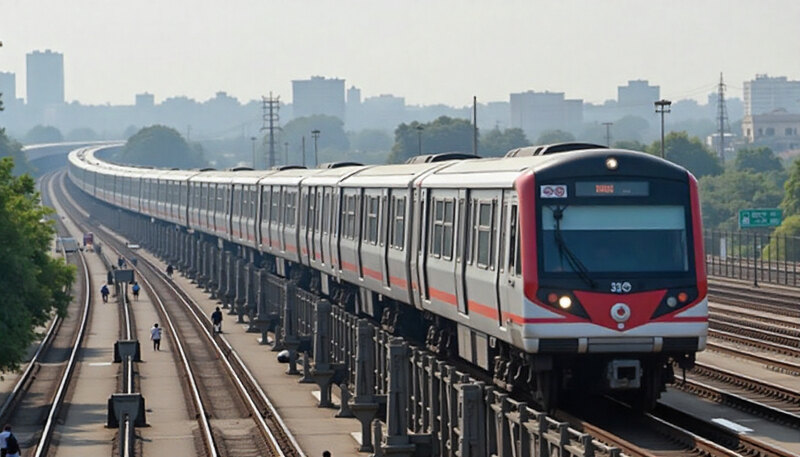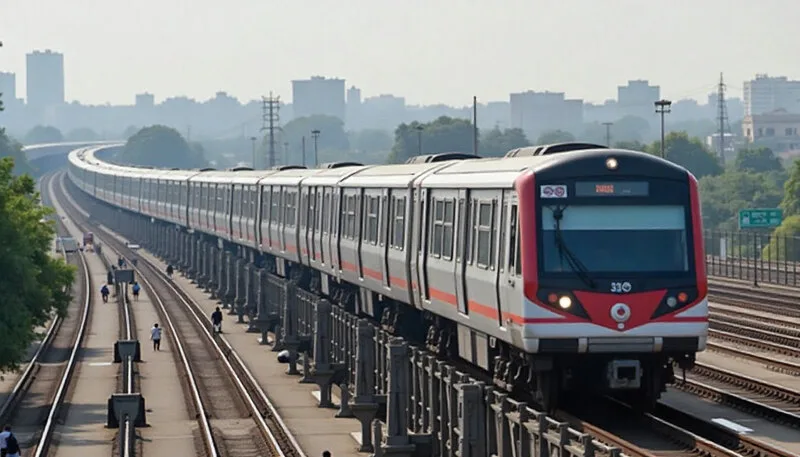Published on
August 19, 2025

Kolkata Metro is set to enhance the city’s connectivity with the much-anticipated inauguration of the Yellow Line extension, stretching from Noapara to Jai Hind Bimanbandar on August 22. This new extension is poised to revolutionize urban transportation by significantly reducing travel time and improving accessibility for thousands of daily commuters. With this expansion, Kolkata Metro aims to ease traffic congestion, promote sustainable travel, and provide a reliable alternative for those traveling to key areas, including the Netaji Subhash Chandra Bose International Airport. The extension not only boosts the metro network but also fosters economic growth by improving connectivity to crucial business hubs and residential areas.
Kolkata Metro’s New Noapara to Jai Hind Bimanbandar Stretch Set to Open: A Milestone in Urban Connectivity
Kolkata’s long-awaited metro expansion is here, with the Noapara to Jai Hind Bimanbandar stretch now ready for commercial operations. This development marks a significant milestone in the city’s public transportation network, offering commuters a quicker, more efficient way to navigate the bustling metropolis. The official inauguration by Prime Minister Narendra Modi is scheduled for August 22, 2025, and it promises to be a game-changer for Kolkata’s transportation system.
Enhancing Connectivity with the Kolkata Metro Yellow Line
The new 6.77-kilometer segment is an integral part of the Kolkata Metro’s Yellow Line, which has been a major initiative to improve the city’s transport infrastructure. With this expansion, the metro network now extends closer to the city’s major hubs, making it even easier for locals to access the city’s most popular destinations. The route provides a direct link to the city’s international gateway, Netaji Subhas Chandra Bose International Airport, located in Bimanbandar, ensuring that travelers and tourists can now commute in comfort and without hassle.
The seamless connectivity to the airport will especially benefit frequent flyers and airport staff, saving time that would otherwise be spent stuck in traffic or waiting for buses. The metro promises a quick, safe, and air-conditioned ride for both tourists and locals, all while contributing to reducing Kolkata’s traffic congestion and pollution.
Kolkata Metro’s Expansion: A Game-Changer for Commuters
The extension from Noapara to Jai Hind Bimanbandar represents a significant leap forward in Kolkata’s metro network. With an investment of approximately Rs 1,866 crore, this new stretch is designed to ease the daily commute for thousands of Kolkata residents, providing much-needed relief from the city’s infamous traffic jams.
This section includes three state-of-the-art metro stations: Dum Dum Cantonment, Jessore, and Jai Hind Bimanbandar. The stations are equipped with modern amenities and are strategically located to cater to commuters from various parts of the city. Whether you are headed to the airport for a flight or commuting to work, these stations promise to be an efficient hub for passengers.
The Key Benefits of the New Noapara to Jai Hind Bimanbandar Route
Improved Connectivity for Local Residents
The newly extended metro line will provide better access to some of the most densely populated areas in Kolkata. Localities such as Baranagar, Tobin Road, Sinthee, Dum Dum, Nagerbazar, and Kaikhali More will benefit immensely from the new stretch. Residents in these areas will enjoy smoother commutes, helping to reduce their travel time and improving access to the central business districts of the city.
For those who rely on buses or auto-rickshaws, the metro offers a faster, more reliable alternative. The station at Dum Dum Cantonment, for instance, provides easy access to the Sealdah-Bongaon Eastern Railway route, creating more transit options for commuters. This opens up greater possibilities for travel across the city and beyond.
Seamless Interchange Between Metro Lines
An additional benefit of the Noapara to Jai Hind Bimanbandar extension is the improved interchange connectivity with the rest of the Kolkata Metro network. The Noapara station, which serves as the northern terminus for the Yellow Line, connects seamlessly with the Blue Line, running from Noapara to Kavi Subhash. This ensures that commuters from the southern parts of the city can easily transfer to the Yellow Line without the hassle of long-distance travel.
The integration of metro lines will undoubtedly streamline commutes for Kolkata residents, allowing them to travel across the city with ease. Additionally, with the metro network expanding and becoming more interconnected, it is expected that the metro will serve as a backbone for the city’s entire transport system, further reducing the dependency on private vehicles.
A Step Toward Sustainable Urban Transport
As Kolkata strives to modernize its public transportation network, the expansion of the metro system represents a crucial step toward sustainable urban mobility. By offering a clean, efficient, and reliable mode of transport, the metro helps reduce air pollution and dependence on fossil fuels. The metro’s electric trains are environmentally friendly, making it a more sustainable alternative compared to traditional forms of transport.
The project also aligns with Kolkata’s broader efforts to improve public infrastructure, ensuring that the city is prepared for its future as a bustling metropolitan hub. With this expansion, Kolkata is on track to create a robust, interconnected transport system that caters to the needs of a growing population and a rapidly expanding economy.
Kolkata Metro’s Yellow Line extension, set to open on August 22, will connect Noapara to Jai Hind Bimanbandar, enhancing city connectivity. The new stretch promises to reduce travel time, ease traffic, and provide smoother access to key locations, including the airport. This expansion boosts convenience for commuters while supporting the city’s sustainable growth.
Looking Ahead: Future Prospects for Kolkata’s Metro Network
The Noapara to Jai Hind Bimanbandar stretch is only one part of the broader metro expansion plan for Kolkata. With several new metro lines already under construction, the future looks promising for the city’s public transport system. The metro is expected to become the go-to option for residents and visitors alike, with future developments aimed at further improving connectivity and reducing congestion.
As the city continues to evolve, the Kolkata Metro will play a vital role in shaping the urban landscape, ensuring smoother commutes and providing a reliable, eco-friendly transportation option for years to come.







